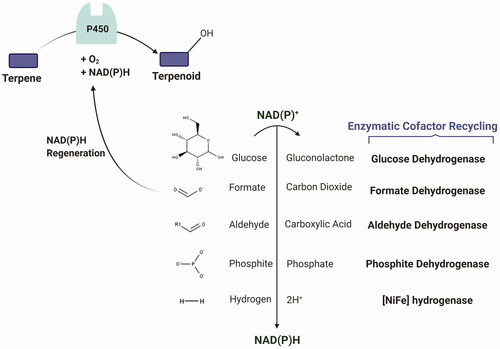Figures & data
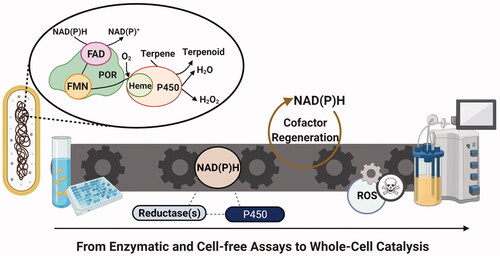
Figure 1. Examples of several widely investigated P450 classes with examples. (A) Class I-P450cam [2GR6]; (B) Class II and Rat Liver POR [1AMO [Citation17]]; (C) Class III-P450cin [1T2B [Citation18]]; (D) Class VII-CYP116B46 [6LAA [Citation19]]; (E) Class VIII-P450BM3 [1BVY [Citation20]]. Fdx: ferredoxin; FMN: flavin mononucleotide; PFOR: phthalate family oxygenase reductase; POR: cytochrome P450 reductase; FAD: flavin adenine dinucleotide; CinA: P450cin heme active site; CinB: P450cin FAD containing protein cindoxin reductase; CinC: P450cin FMN containing flavodoxin [Citation21]. Figure created with BioRender.com.
![Figure 1. Examples of several widely investigated P450 classes with examples. (A) Class I-P450cam [2GR6]; (B) Class II and Rat Liver POR [1AMO [Citation17]]; (C) Class III-P450cin [1T2B [Citation18]]; (D) Class VII-CYP116B46 [6LAA [Citation19]]; (E) Class VIII-P450BM3 [1BVY [Citation20]]. Fdx: ferredoxin; FMN: flavin mononucleotide; PFOR: phthalate family oxygenase reductase; POR: cytochrome P450 reductase; FAD: flavin adenine dinucleotide; CinA: P450cin heme active site; CinB: P450cin FAD containing protein cindoxin reductase; CinC: P450cin FMN containing flavodoxin [Citation21]. Figure created with BioRender.com.](/cms/asset/f463960f-06cf-40e8-9ec0-688b42664814/ibty_a_1990210_f0001_c.jpg)
Figure 2. Cytochrome b5 mechanism of action. Cytochrome b5 (Cb5) acts as an electron buffer for P450 enzyme and can transfer the second electron from cytochrome b5 reductase or cytochrome P450 reductase to P450 enzyme. Adapted with modifications from [Citation56,Citation57]. Figure created with BioRender.com.
![Figure 2. Cytochrome b5 mechanism of action. Cytochrome b5 (Cb5) acts as an electron buffer for P450 enzyme and can transfer the second electron from cytochrome b5 reductase or cytochrome P450 reductase to P450 enzyme. Adapted with modifications from [Citation56,Citation57]. Figure created with BioRender.com.](/cms/asset/3d45435e-c690-4625-addd-c291a3b39cff/ibty_a_1990210_f0002_c.jpg)
Figure 3. Immobilisation techniques with potential for P450-mediated biocatalysis. (A) Nanodiscs resemble the plant lipid bilayer membranes for P450 and reductase immobilisation and can improve P450 solubility (B) Immobilisation of self-sufficient (reductase-free) P450s on E. coli poly(3-hydroxybutyrate) granules increases the P450 enzyme solubility and activity under harsh reaction conditions. Adapted with modifications from [Citation99]. Figure created with BioRender.com
![Figure 3. Immobilisation techniques with potential for P450-mediated biocatalysis. (A) Nanodiscs resemble the plant lipid bilayer membranes for P450 and reductase immobilisation and can improve P450 solubility (B) Immobilisation of self-sufficient (reductase-free) P450s on E. coli poly(3-hydroxybutyrate) granules increases the P450 enzyme solubility and activity under harsh reaction conditions. Adapted with modifications from [Citation99]. Figure created with BioRender.com](/cms/asset/a2a756fb-6b8c-4800-8c95-22765bc645b7/ibty_a_1990210_f0003_c.jpg)
Figure 4. DuaLinX method. In this system, E. coli flavodoxin (FldA) and flavodoxin reductase (Fpr) are fused with a proline- or glycine-rich linker in any of N- or C-termini attachment orientations, through insertion of an NcoI restriction enzyme site between these two genes. Figure created with BioRender.com.
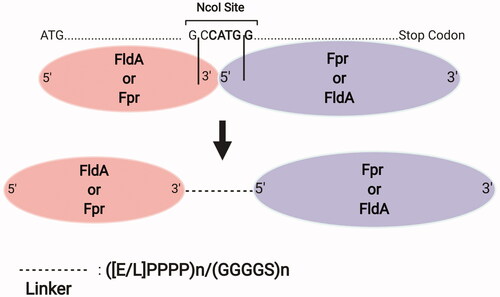
Figure 5. PUPPET system. In this system, the N-termini of Pseudomonas putida P450 components are attached to C-termini of Sulfolobus solfataricus heterotrimeric proliferating cell nuclear antigen (PCNA), which enables the colocalisation of the redox and P450 enzymes. Adapted with modifications from [Citation147]. Figure created with BioRender.com.
![Figure 5. PUPPET system. In this system, the N-termini of Pseudomonas putida P450 components are attached to C-termini of Sulfolobus solfataricus heterotrimeric proliferating cell nuclear antigen (PCNA), which enables the colocalisation of the redox and P450 enzymes. Adapted with modifications from [Citation147]. Figure created with BioRender.com.](/cms/asset/97d28c9e-c7c6-4307-83e3-f830403e7efc/ibty_a_1990210_f0005_c.jpg)
Figure 6. A hypothetical representation of bioelectrocatalytic, cell-free system for self-sufficient P450-mediated production of terpenoids. Either the self-sufficient P450-expressing crude microbial cell extract with ferredoxin or electrode-bound purified P450 enzyme can be used to potentially hydroxylate the terpenes. The redox potential is simultaneously monitored with a potentiostat device. Figure created with BioRender.com.
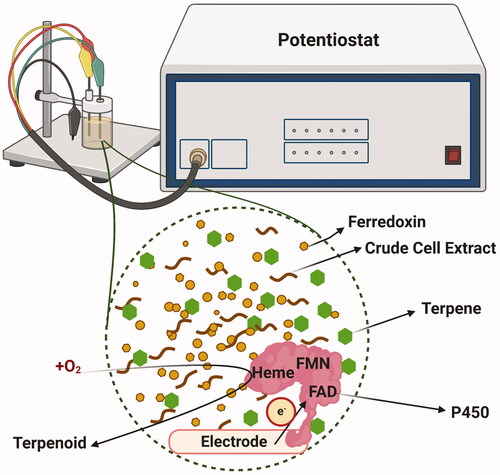
Figure 7. Schematic of photochemical-mediated P450 catalysis in in vitro systems for terpenoids synthesis. Photosensitisers are light-harvesting units that provide electrons to P450 enzymes for biosynthesis. MarvinSketch 20.17.0 was used for displaying the chemical structures, ChemAxon (https://www.chemaxon.com). Figure created with BioRender.com.
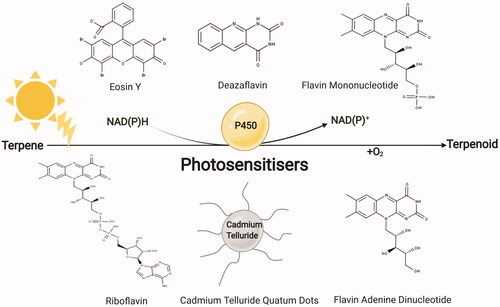
Figure 8. Photosynthetic electron transport chain reduces NAD(P) to fuel terpenoid biosynthesis by P450 enzymes. PSI: Photosystem I; PSII: Photosystem II; PQ: Plastoquinone; FNR: Ferredoxin-NADP+ oxidoreductase; Fdx: Ferredoxin; NDH-1: NADPH dehydrogenase; SOD: Superoxide dismutase; Cyt b6/f Complex: Cytochrome b6f complex. Adapted from “Light Dependent Reactions of Photosynthesis”, by BioRender.com (2021). Retrieved from https://app.biorender.com/biorender-templates
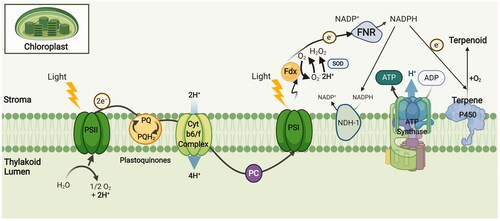
Figure 9. Selection of enzymatic routes to NAD(P)H regeneration for P450-mediated terpenoid synthesis. Figure created with BioRender.com.
